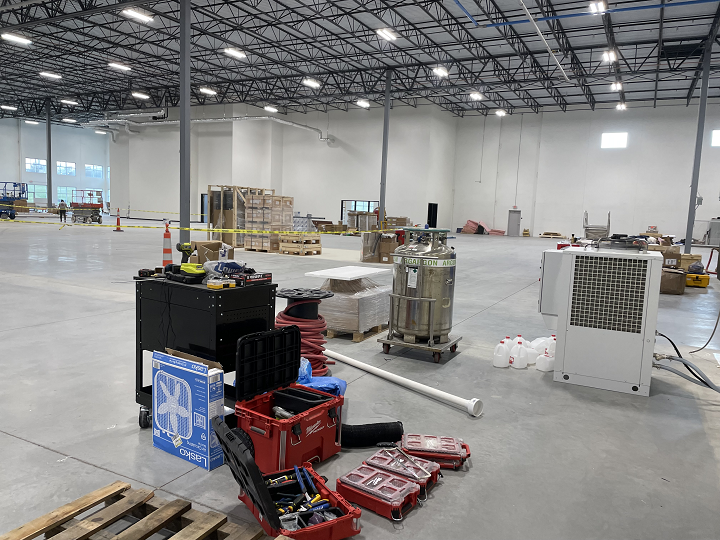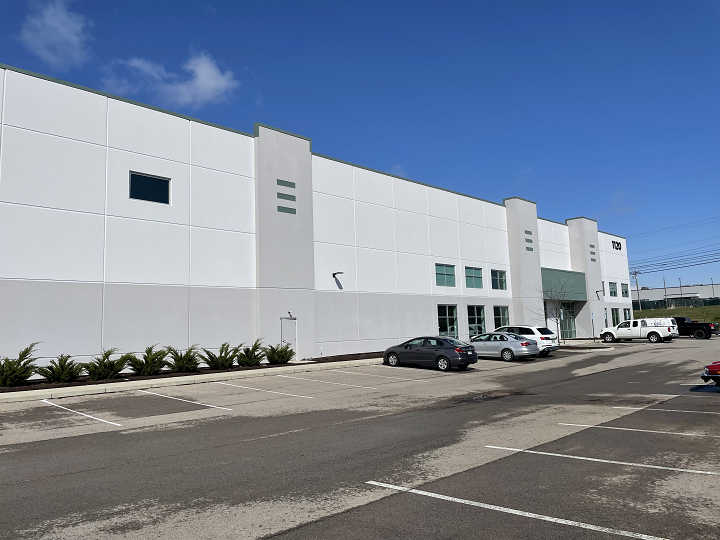In the previous post in this series, I gave an overview of some of the operations that will take place at the new 73,000-square-foot facility being launched by Zeda. The company, formed through the acquisition of Vertex Manufacturing by PrinterPrezz, combine the aerospace, space, and industrial expertise of Greg Morris’s Vertex Manufacturing and Shri Shetty, formerly of PrinterPrezz and now CEO of Zeda. In that post, we learned how those two sides of the company will be embodied in the new facility, as well as some of the automation that will be executed there. Here, I’ll go into greater depth about how the site was planned and how it fits into the larger idea of re-shoring manufacturing to the United States.
Designing and Building the Zeda Plant
Shetty explained that it took about six months to design the facility, get the proper city permits, and put in all the lines, and then another five months to actually build it out.
“It took us more time to design it than to build it, because a facility like this does not exist, and there are very specific requirements, both from the non-medical side and the medical side, so it took us a long time to design this,” he continued. “It’ll look pretty different than anything else out there, because a lot of it will be digital as well.”
Even the large shipping and receiving area was well-thought out before it went into construction.
“A lot of people sort of cram it into a small area and that’s a mistake because there’s a lot of activity back there every day,” Morris said. “So, we have a nice area that’ll be walled off, and we’ll also keep our inventory and stock back here.”
I noted the vast number of obviously necessary bay doors, and Morris said that the feature wasn’t even something Zeda had added. In planning its advanced manufacturing facility, the company had considered buying an existing machine shop, but chose instead to build up the factory from a mostly empty Amazon site, because, as Shetty explained, “it needs to be designed and built a certain way…It took us almost a year to design the facility before we started building it.” Zeda is converting one-third of the Amazon building to its own use, but the shell of it, like the walls and ceiling, was already built prior to the company leasing the space. Morris said that, once it’s done, it will be a “pretty unique manufacturing space.”
“First off, the facility itself, like Shri just mentioned—all the different electric lines, gas lines, all the different things we need for the specific equipment we use—you could argue that’s not so unique. Fair,” he continued. “But the high bay, and getting all this stuff so it’s exactly what we need, is pretty important. Really, I would say the advanced manufacturing aspect of this is not very common. You’re combining leading-edge technologies, like additive metals, and traditional technologies, such as advanced CNC machining, and other capabilities that are very uncommon. But it’s really sort of the way of manufacturing in the future. When we’re done, this facility will just really look like a very advanced, high-tech manufacturing facility. And, frankly, it’s one of the things we want to start changing people’s opinion about: what is manufacturing, and what is it today? Of course, there are a lot of geopolitical discussions about trying to bring manufacturing back into the United States. I think this is the type of high-value manufacturing that we’re talking about, and this will be a great example of that.”
The Silicon Valley of Additive
Settling back into the conference room, Morris and I had a long chat about all of the manufacturing innovation currently happening in the Midwest, starting when I asked if Zeda did any work with Wright Patterson Air Force Base (WPAFB) or the Air Force Research Lab (AFRL) on base, which is only about 50 miles northeast of the new Zeda factory.
“Indirectly, yes,” Morris answered. “And probably we have in the past, as our previous company. So, I think the opportunities exist to be doing stuff directly with them again. But, most of it is indirect through people that supplied a product to them, and we’re working with those companies.”
He thinks this region, including Ohio, western Pennsylvania, Tennessee, Indiana, and maybe southern Michigan, should be promoted “as the Silicon Valley of additive,” what with all of the industry and universities in the area working with additive metals.
 Taken in 2021; from left: Noah Gula (Graduate Research Assistant, CDME), Sammy Passell (Process and Applications Engineer, AddUp), Nathanael Henry (Research Assistant, CDME), Ben DiMarco (Additive Manufacturing Technologist, CDME).
Taken in 2021; from left: Noah Gula (Graduate Research Assistant, CDME), Sammy Passell (Process and Applications Engineer, AddUp), Nathanael Henry (Research Assistant, CDME), Ben DiMarco (Additive Manufacturing Technologist, CDME).“I will give the state credit. They have worked very hard to try to attract the aviation and space industry folks here,” he continued. “But there are so many things in Ohio. People don’t really have any idea. We have a lot going for us here. People just don’t think about the Midwest and this region as necessarily being as advanced as it is. And I would pit what this facility is in the additive space, or just advanced manufacturing, against any other facility in the U.S. And really, the timing is pretty good because we’re starting to see, in my opinion, one of the largest increases in applications and usage of additive in particular for metals, that I’ve seen since really, probably 2003 when we first introduced the additive metals to the North American market. So, you know, it’s taken this long, 20 years, but we’re there and a lot of companies are starting to leverage it and use it.”
The conversation continued, changing to the fact that over the last 20-30 years, the U.S. has been outsourcing core manufacturing from the Midwest, and other regions of the country, to Asia, which led to the “whole Walmart revolution.”
“And the challenge is that we started outsourcing stuff that we shouldn’t have. So a lot of the regulated industries, defense, aerospace, medical, critical supplies, started being outsourced to countries where it took away some of the core competencies that the U.S. had,” Zeda’s Co-Founder and COO Kishore Karkera said. “With COVID, it has become very clear that supply chain for medical is very critical, and a lot of countries have realized that having a local supply chain is very critical. And some of the macropolitical situations with the Ukraine war and US-Asia conflicts are making it more and more evident that localization of critical supplies is critical.”
Shetty noted that many large companies have now realized that “additive could be a good technology disruption that could help with recapitalization or reshoring of manufacturing.”
“The reason this part of the country is very interesting is that though the rest of the country, like the East Coast or the South, has lost a lot of its core manufacturing skillset, Ohio still seems to have, across the last 20 years and even after the death of the steel industry, talent in the manufacturing space, driven by GE and others…Ohio, or the Midwest on the whole, will be where it starts because still the cost economics are here and the talent pool is here.”
There’s been an ongoing trend towards localization of manufacturing, with many countries, the U.S. included, realizing they want manufacturing independence from China. As Shetty explained, this kind of facility could replace a lot of manufacturing space in China, “because our digital technologies are not only eco-friendly, but they also are space friendly.”
“Everything around additive and all the other stuff that Greg said is true, but those are the trends that we see in regulated markets. I mean, we don’t see it ending anytime. But we don’t look at it as something that we can do by ourselves. We require partners, not only customers, software partners, hardware partners like AddUp, the government partners, the press. It’s a giant effort. This is not going to just happen. It requires a lot of education, a lot of understanding of value.”
I asked if Zeda was planning for any acquisitions, and Shetty said the company has already completed three acquisitions, with the third not yet public. He explained that part of its model is acquiring companies, and then using them to create group companies that can grow.
“I think the reason why we have built this facility up here is it’s a model facility for us to put McDonald’s-like facilities across the globe. So, you know, we can put something in Europe that can support Europe, something in Singapore that can support Singapore. It’s a good model, especially in the medical space. We will not do that on the aerospace and defense side just because of logistical and confidentiality reasons. But we think these trends of putting factories across the globe make more and more sense to us.”
I’d never heard localized manufacturing clusters described in quite this way before, like a McDonald’s franchise, but it makes a lot of sense.
It was a very informative and interesting visit, and I hope to make it back down to Cincinnati when Zeda officially opens this unique facility.
Subscribe to Our Email Newsletter
Stay up-to-date on all the latest news from the 3D printing industry and receive information and offers from third party vendors.
Print Services
Upload your 3D Models and get them printed quickly and efficiently.
You May Also Like
Consolidation in AM: How 2025 Is Shaping the Industry’s New Normal
The first half of 2025 has been marked by a clear shift in the additive manufacturing (AM) industry. Companies are no longer just focused on developing new tech by themselves....
Etsy Design Rule Change Reduces Selection of 3D Printed Goods
Online marketplace Etsy has implemented a rule change requiring all 3D printed goods on the site to be original designs. The update to the site’s Creativity Standards states, ¨Items produced using...
U.S. Congress Calls Out 3D Printing in Proposal for Commercial Reserve Manufacturing Network
Last week, the U.S. House of Representatives’ Appropriations Committee moved the FY 2026 defense bill forward to the House floor. Included in the legislation is a $131 million proposal for...
Transforming From Tourist to Native: Duro CEO Michael Corr Explains Why the Company Rebuilt its PLM Software on AI
In these early innings of the AI boom, many market analysts have expressed concern that AI spend has gotten too far ahead of the technology’s proven ability to deliver significant...




































